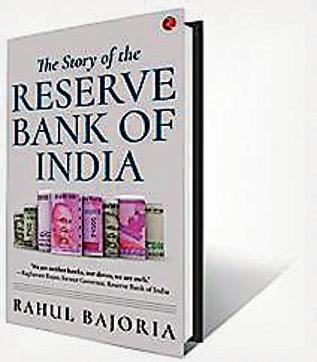Review: The Story of the Reserve Bank of India by Rahul Bajoria
The RBI’s toils and travails through decades of a rollercoaster fiscal ecosystem that saw devaluation, bank nationalisation, bankruptcy, liberalisation, and demonetisation

The venerable Reserve Bank of India (RBI) is a profoundly difficult subject for biography. Its key responsibilities – interest rate policy, deficit financing, credit policy, management of sub-standard banks et al -- aren’t quite the juicy, meaty, spicy stuff millennial biographies are made of. Yet, with legerdemain rare among corporate biographers, Singapore educated and based economist Rahul Bajoria tells a well researched and undeniably neutral “story”.
Bajoria’s narrative style is sturdy and stable. He describes with equanimity RBI’s birth legislated in 1935 by an act of parliament in Westminster after 80 years of intense colonial debate culminating in the Royal Commission of 1925. Today, few care to learn about Dr BR Ambedkar’s famous testimony expressing the view that the power of issuing currency should be taken away from government. Ambedkar also wrote a book The Problem of the Rupee: Its origin and its solution.
Few, too, know how conflict between the RBI and the government began almost from Day One. Bajoria is free and frank. RBI’s first governor Sir Osborne Arkell Smith was vocal on facing day-to-day interference and reciprocally, the government was “clearly unhappy” with Smith who faced fierce revenge. To “fix” Smith, rumours about his unsavoury character, including being a “womaniser” began circulating. The book notes “government went to extraordinary lengths to push Smith out.” He resigned in October 1936.
Bajoria quietly cites past differences between the RBI’s central boards and government. Sounds familiar today, doesn’t it? Personality clashes abounded then as much as now. When the government and the RBI were studying the pro-IMF proposals of Lord John Maynard Keynes, RBI’s second governor Sir James Taylor wrote privately to a friend that Keynes was “a monetary quack preferring a monetary panacea of the worst inflationary type.”
After independence, the RBI adapted to an economic environment that was initially benign and conducive to focusing on the arduous task of nation building. Nehru appointed RBI Governor Chintaman Deshmukh concurrently as finance minister of India and member, Planning Commission. RBI became government’s important ally and helped design and set up several agencies to aid the process of industrialisation. As custodian of India’s sterling balances and banker to the government, the RBI faced the challenge of balancing short-term price pressures with long-term investment requirements.
Politics affected RBI for the first time in 1956 when Rama Rau was governor. Deshmukh resigned as finance minister in 1956. Nehru replaced him with the sharp-tongued businessman TT Krishnamachari (TTK) who had little time for bureaucrats or procedure, pressed for industrialisation via the deficit financing route, and even made an announcement that was the opposite of the RBI’s stance. Governor Rama Rau wrote to Nehru about TTK’s “personal rudeness,” passing “rude remarks” and “indulging in rude behaviour.” In retaliation, TTK called RBI “a section of the finance ministry” and let fly “in the loudest of voices” as to who was in charge. Rama Rau protested but Nehru replied, “If you so wish, you can submit your formal resignation.” The resignation was “promptly accepted” recounts Bajoria. This answered the extraordinary “Who’s the boss?” debate between politics and professionalism.

Bajoria’s riveting “story” covers RBI’s toils and travails through subsequent decades of a rollercoaster fiscal ecosystem that saw devaluation, bank nationalisation, populism, a right-wing government, populism again, bankruptcy, liberalization, and demonetisation in 2016 when, says Bajoria, RBI “was a critical but perhaps unwilling participant.”. The problem was five decades old as RBI wasn’t always involved in policymaking.
Some chapter titles suggest the kind of convolutions it survived: ‘Crisis and Consolidation’, ‘A sharp left turn’, ‘Out of the frying pan into the fire’, ‘Broke and on the brink’, ‘Ascending, descending’, ‘Conflict, collaboration and catharsis’.
Read more: Ex-RBI governor Bimal Jalan: Government is ultimately the highest authority
In a nutshell, Bajoria’s personal view is optimistic. “RBI occupies the primal position in India’s financial labyrinth as far as the regulatory space is concerned. RBI will continue to remain fundamentally dominant and indispensable to India’s body politic for decades to come.”To understand why and how, every babu and neta must read this book. Will they? I wonder.
Sujoy Gupta is a business historian and corporate biographer



